Happening Now
Riding The Amtrak Ethan Allen Express
August 4, 2022
The second in a series of guest blogs from long-time advocate & past Rail Passengers Vice-Chair Carl Fowler
by Carl Fowler
Member, Vermont Rail Advisory Council
Past Vice Chair of the RPA
Retired President Rail Travel Center/Rail Travel Adventures
On July 29, 2022, true interstate passenger rail service returned after a gap of 69 years to Burlington, Vergennes, and Middlebury, Vermont—continuing via Rutland, Saratoga Springs, Schenectady, Albany and there down the magnificent former New York Central “Water Level Route” along the Hudson River to New York City. The ETHAN ALLEN EXPRESS is extended 67 miles further north to connect western Vermont and the Champlain Valley to the Amtrak National Network. It was a great day!
The crowd began to gather just after 800AM for the 1010AM departure of the first passenger train south on the former Rutland RR northern mainline since June 26, 1953. The Vermont media has done a superb job of covering the relaunch ceremonies, so this article will concentrate on offering a look at the on-board experience, scenery and connecting services now made available by the addition of this train. We will primarily focus on the route from Burlington to Rutland but will note highlights south to Pennsylvania Station in New York City.
Northern Vermont has been served since May 1, 1995, by the VERMONTER Amtrak service, which follows the rugged former Central Vermont RY (CV)—now New England Central (NECR) line, crossing over the Green Mountains and down the lovely Connecticut River Valley. This train has gained remarkable ridership when contrasted with what the CV was handling itself in the 1960s. In FY 2019 ridership had reached 98,168, comparted to fewer than 50,000 annually on the historic “Ambassador” daylight service in the final years before Amtrak. But the VERMONTER has long lacked useful enroute connections to the rest of the Amtrak system. Its route simply does not adapt to reaching Springfield or New York early enough in the day to make same-day connections to Amtrak’s national network. The train essentially provides an isolated service from St. Albans to Springfield, New Haven, New York, Philadelphia, Baltimore and Washington, D.C., although of course it reaches millions of prospective riders even without same-day connections.
The newly extended ETHAN ALLEN EXPRESS restores excellent connectivity at Albany with the LAKESHORE LIMITED and Amtrak’s “Empire Service” for all points west. And the newly extended train is supplemented by a properly coordinated twice-daily Burlington to Albany Amtrak Thruway “Ambus” service, provided by Vermont Translines. This will open connections at New York to the southeast and Florida once the SILVER METEOR resumes operations on October 3.
As a designated Amtrak Thruway these bus trips can be booked and ticketed through Amtrak and go directly to the Amtrak Albany station. The result is a thrice daily service (1 train/2 buses) from Burlington, Vergennes, Middlebury and Rutland to Albany. The two bus trips additionally provide Amtrak connections at Albany for passengers from the southwestern Vermont towns of Brandon, Wallingford, Manchester Center and Bennington—towns not on the currently operating train line.
While it will be a few years yet, the longer term the Vermont State Rail Plan envisions restored passenger train service south of Rutland to Manchester, and Bennington and onward to Albany. This service would use the Vermont Rail System’s (VRS) former Rutland RR mainline south of Rutland to Hoosic Jct, NY and then CSX’s former Boston and Maine “Hoosic Tunnel” route to Schenectady and the current Amtrak route to Albany. The portion of this line in Vermont is currently being upgraded to handle heavier 286,000-pound freight loads. New welded rail, ties and ballast are also being installed. In a few years a second daily passenger train over the Western Vermont Corridor should go this way.
Now let’s ride the ETHAN ALLEN EXPRESS from Burlington to New York. The gloriously restored Burlington Union Station is our boarding point. This may be the classiest Amtrak station in the northeast staffed only by caretakers. The new trackside waiting room alone is immense, with grand historic wooden bench seats and a stately covered passageway to the tracks. Above the platform at the Main Street level is an outdoor viewing terrace, from which sweeping views can be enjoyed of the Burlington waterfront and Lake Champlain. There is even a touch of humor on the front and rear facades of the building—gargoyles in the form of giant flying monkeys stand guard!
The only discordant note here is the lack of any dedicated Amtrak parking. The large Union Station lot belongs to the station’s owners--Main Street Landing (MSL) and for good reasons does not permit overnight stays. These spots are reserved for MSL tenants and residents. When not completely full same-day parking between 800AM and 1100PM is available there for $10. There are city lots very near-by and those will have to be the answer. VTRANS and the city should negotiate for the use of one of the essentially adjacent Waterfront Lots.
The nearest city parking lot permitting overnight stays is only 2 ½ blocks away behind the Hilton Hotel—the Burlington “Downtown” Garage, with entrances off both College and Battery Streets. The fee there is a reasonable $8.00 per day, but the garage is uphill (and not visible) from the station. At least at present there is no signage to it at the depot, nor is it properly referenced in the station profiles at Amtrak.com. Other closer city lots do not offer all day or overnight options.
Almost immediately upon departure lovely views of Lake Champlain and the Adirondack Mountains across the lake in New York appear. The train begins an ascent up from the lakeshore to Shelburne and the countryside opens-up to reveal the classic Vermont landscape of dairy farms, substantial barns, quaint farmhouses and now fields of wine grapes as well as carefully tended pastures and corn fields. In contrast to the rugged country along the VERMONTER route, this is a far more pastoral landscape, but there are frequent views east to the high peaks of the northern Green Mountains and west to the even more rugged Adirondacks.
The first stop is at Vergennes, which Amtrak calls Ferrisburgh/Vergennes, as the stop lies right on the border of the two communities. The 1851 Vergennes station building has been moved about a half mile from a previous location that was buried behind a former furniture factory. Is this perhaps the oldest station building in regular use on Amtrak? I welcome updates. VTRANS created a text-book example of a multi-modal station here, with a large park-n-ride lot and proper train and bus loading areas. As there is no public parking dedicated to Amtrak (at least not yet) in Burlington, this stop—only 21 miles south of Burlington--should pull substantial ridership with its offer of free parking.
Departing Vergennes the line crosses a height of land and traverses the high bridge over the New Haven River, before arriving at Middlebury, home to Middlebury College and the summer Bread-Loaf Writers Retreat. The new platform here is directly across from the historic dept—but that building is in private hands and was not acquired for the new service. It is anticipated that this will be a busy stop and it is regrettable that the only cover here is the platform canopy. It will be cold indeed waiting for the train in the winter. The town chose this location for the station to reflect its historic placement, which is close to the still vibrant town center, but the available space is limited. At best only a tiny shelter could be erected here. The college campus is about a mile south. There are 8 parking spaces, but for long-term stays this will be mostly a “kiss-n-ride” facility. I think many passengers will opt to park and board at Vergennes, 13 miles to the north.
The opening of the extension of the ETHAN ALLEN route was postponed for several years because of a remarkable (and unforeseen) engineering accomplishment by VTRANS and VRS here in Middlebury. There was a century-old street bridge structure over the tracks adjacent to the falls of the Otter Creek, which was badly rusted out and urgently needed to be replaced. This structure supported several downtown buildings as well. But the proximity of the creek made additional drainage essential here as well and there was also the need to improve clearances to allow modern double-stack and high/wide freight cars (and perhaps someday bi-level coaches) to pass. The result was a complete rebuild of the tracks and structures, with a custom designed tunnel installed on a completely new grade to accommodate the VRS rail tracks. The clearance here is now 19 feet!
But during the two summers that this project was underway no work could be done on the new Amtrak station, as its platform terminates right where the new grade down into the short tunnel begins. In addition, VRS freight traffic destined to Burlington and Middlebury had to be detoured for several months each year from Rutland over the Green Mountains to Bellows Falls, where the freight trains were forwarded by the New England Central RR (normally a VRS competitor) Bellows Falls--White River Jct.-- Essex Jct.—Burlington, before regaining VRS rails to reach customers in the area north of Middlebury. This was a very complex project indeed!
Departing Middlebury the train traverses the new tunnel and heads south into a marshy region—passing non-stop through Leicester Jct. This was the junction point in Rutland RR days for the Addison Branch, which once crossed Lake Champlain to Ticonderoga, NY. This bucolic branch had an on-line covered bridge near Shoreham, which can still be visited on a quiet walk along the abandoned grade. VRS relaid a short piece of the Addison branch in conjunction with the passenger service project which will be used to store freight cars.
After passing through Brandon the line enters the marble quarry region. The most important shipper on the VRS system is the OMYA company, which quarries and processes Vermont marble into a slurry that can be used to make paints, and other products. Long fleets of specially adapted tank cars will be seen here as the train passes through the just-expanded OMYA yards. Nearing Proctor there is a covered bridge adjacent to the east side of the track, and the train passes the marble block “yard” adjacent to the Vermont Marble Museum.
At Center Rutland the historic depot is now the Rutland Railroad Museum. The tracks curving off to the right are the route the train will take departing Rutland enroute to Whitehall, NY. Because the Amtrak Rutland station is a mile and a half south of the junction the train will reverse direction at Rutland upon departure—which is the reason the ETHAN ALLEN has Amtrak engines on both ends of the train.
Arriving Rutland, 67 miles south of Burlington, we reach the modern Senator James Jeffords Memorial Rutland Amtrak depot, where the newly restored line ends. Although staffed only by a caretaker this is a bright modern station with short and long-term parking and the only high-level platform currently in use in Vermont.
Rutland was a classic New England industrial city and was the headquarters of the original Rutland RR. The closure of the Rutland system in 1961 led the state of Vermont to buy most of the line under the leadership of then Governor Phil Hoff, to preserve freight service by rail in western Vermont. This action was practically unprecedented at the time. The state elected to have a contractor operate the state-owned network, a role assumed by the Wulfson family for two generations. First under the leadership of founder Jay Wulfson and then by present VRS CEO David Wulfson, the Vermont Rail System has not only restored viable freight service over routes all over Vermont but has also served as a model operator of both tourist and Amtrak passenger trains. VRS has benefited from extensive upgrades of its network to facilitate passenger service that have also vastly improved the “state of good repair” standard for freight as well.
The “look” of downtown Rutland is much changed from peak railroad days. The vast former yards, shops and station complex have been dramatically reduced, with much of the previous station/railroad area now occupied by a Walmart-anchored shopping mall. But Rutland still is a city of grand public, commercial and church buildings and of neighborhoods ranging from Victorian mansions to former workers’ apartments.
Before we depart for New York let me share a slight digression here. The ETHAN ALLEN EXPRESS owns a unique Amtrak record twice. When service resumed from Whitehall to Rutland in 1996 it replaced an interstate service dropped by the Delaware and Hudson Ry when it conceded the Vermont passenger market to the Rutland RR in 1937—59 years previously. When service was extended from Rutland to Burlington that reset the record to 69 years!
Another fun fact also makes an important point about what is possible with Amtrak. It is hard to imagine service returning to a line like the BNSF secondary mainline from Fort Collins, CO through Denver to Colorado Springs and Pueblo—which last saw passenger trains south of Denver in 1971 and on the north end in 1968—yet I firmly believe that will happen. There is literally a market of millions of potential riders on offer there. Dozens of other examples exist nation-wide. And adding frequencies to existing routes increases ridership without exponentially raising costs. More below!
If we in Vermont can finally upgrade the only 7.86 mile-long Burlington to Essex Jct. branch of the NECR to passenger standards, we can unite our two state of the art rural passenger routes. Montreal, Quebec is only 65 miles from the current Vermont terminal at St. Albans. Over 4,000,000 riders are so close! VTRANS has stated that reaching Montreal will be its next passenger priority. I am truly all aboard.
The Vermont State Rail Plan envisions the restoration of the overnight MONTREALER after we reach Montreal, to complement our daylight services. This will open our lines to a completely different market—business and tourist riders who might want a morning arrival time to spend a day in northern Vermont, Montreal or New York City without having to pay for two nights in a hotel, as is needed today at those points to permit any time for business or sightseeing. By running both day and night trains we will not only open new markets but far better use the infrastructure we’ve worked so hard to recreate. The new ETHAN ALLEN EXPRESS line alone represents an investment of at least $115.000,000.
We passenger rail advocates sometimes undersell in our own minds what might be. I know, because I used to pour cold water on the idea that Amtrak might ever run from Boston North Station to Portland, Maine (not to mention to Freeport (LL Bean) and Brunswick. Yet in FY 2019 the reinstated DOWNEASTER trains carried 552, 460 passengers on no less than five daily rips in each direction. Those five daily DOWNEASTERS generate over five times the VERMONTER’s ridership for only about 40% more subsidy than we pay Amtrak for our once daily trains. Ridership follows frequency, but costs do not exponentially grow!
Departing Rutland, the ETHAN ALLEN EXPRESS follows the only route fully owned by the Vermont Rail System—its Clarendon and Pittsford RR subsidiary. This was formerly the D&H Rutland—Whitehall, NY branch, before being purchased by VRS in 1983. The only stop in this district is the Vermont State University town of Castleton—whose pretty former D&H depot now serves both Amtrak and as an in-station deli offering snacks to enjoy on the train.
When Vermont Governor Howard Dean, and US Senator Jim Jeffords began the push to serve the western side of Vermont in 1995 not only did VRS support the addition of passenger service, but they also put $1,000,000 of VRS funds into a match pot with a $3,500,000 Federal grant and another $743,000 from the state of Vermont to facilitate the restoration of passenger service as far as Rutland. As an example of how this passenger/freight partnership helped both modes, when VRS bought the D&H Rutland line sections of the 23 mile-long route were so deteriorated that the speed limit had dropped to 10mph. Now it’s 59mph on the newly renovated segments.
South of Whitehall the ETHAN ALLEN accelerates to 79mph on much of the Canadian Pacific’s former D&H mainline to Schenectady, then to 105mph on tangent (straight) track from Schenectady to the West Albany yards and again to 105mph from just south of Albany to just north of Hudson and finally south to New York runs at “only” to 79-95mph down the magnificently engineered former New York Central mainline. If we install lineside signals from Rutland to Burlington we could immediately increase speeds on straight track segments to 79mph there as well.
The scenery between Whitehall and Schenectady is mostly second growth forest, although there are glimpses of the Champlain Canal and two sets of locks enroute to Fort Edward, which is the station for Glens Falls and Lake George. The former D&H depot on the west side of the track is a beautiful example of D&H English inspired architecture. The Saratoga Springs station is more modern but has great interior decor paying homage to Saratoga's horse-racing tradition and also serves as a joint rail/intercity bus stop.
Approaching the Amtrak Albany/Rensselaer station the train crosses the Hudson River and there are great views of the Albany skyline. The spectacular building that looks like the English House of Commons is not the state capitol. Rather it was built as the headquarters of the Delaware and Hudson RR (and Canal) --but today provides the administrative offices for the State University of New York (SUNY) system. The real NY State capitol buildings lie at the crest of the hill overlooking the river and include the massive "Empire State Plaza" towers and architectural half-grapefruit, (or is it an egg cut open?), which is actually a performing arts auditorium known--no joke--as "The Egg Performing Arts Center". This complex was sardonically called "Governor Nelson Rockefeller"s Edifice Complex" by its critics during its permitting and construction. On a positive note, the superb New York State Museum occupies part of this site and is an outstanding combined history and natural history museum.
Be sure to get a seat on the right-hand side of the train in the direction of travel from Albany south to New York (and sit on the left going north on this line). Here for 141 miles the track closely follows the east shore of the Hudson River. On the western horizon the peaks of the Catskill Mountains soar over 3500 feet upwards from the river valley. Lighthouses dot islands and reefs and grand Victorian mansions crown the cliffs. South of Poughkeepsie the Hudson cuts a magnificent gorge through the Ramapo Mountains and the train offers heart-stopping views of West Point, Bear Mountain, and the haunting ruins of the Bannerman Castle. The New York Central promoted this as “The Scenic Water Level Route” and that was an understatement! This is one of the most scenic passenger train routes in North America.
Last stop seven- and one-half hours from Burlington is the spectacular new Moynihan Train Hall at Pennsylvania Station New York. For the first time since the 1960s destruction of the original Penn Station (and Amtrak’s 1980s departure from the still glorious Grand Central Terminal) Amtrak passengers in New York have a station fit to serve America’s largest city.
A few final notes: Both the ETHAN ALLEN EXPRESS and the VERMONTER use Amtrak’s 1970s Amfleet 1 coaches. These were the final fleet delivered for intercity Amtrak service by the legendary Budd Company. Nearly 50 years later they soldier on with remarkable reliability.
The Vermont trains all feature renovated coaches, with new leather seat upholstery. There is also a sort of under the radar upgrade available on these trains. Each café-lounge car retains a 16-18 seat “Business Class” section, with foot and leg rest reclining seats (like a Lazy Boy chair), extra legroom and the added space gained by having only one seat on one side of each seating row with 2 sears across the aisle. On most Northeast Corridor trains Business Class no longer provides this 2/1 seating with so much extra space and comfort. These cars were the successor to the daylight First Class equipment that the private carriers had sold as the Parlor Car. The extra cost for this accommodation is well worth the added price.
It is also worth admitting that the initial schedule between Burlington and Rutland seems to be nearly 20 minutes longer than required. Amtrak is allowing two hours each way—but in 1940 the Rutland’s southbound “Green Mountain Flyer” covered this stretch in one hour/40 minutes, drawn by steam engines, with six regular and/or flag stops—in contrast to only two enroute stops today. We know time can be cut with experience, because the July 29 inaugural train left Middlebury 22 minutes late yet arrived Rutland on-time!
A minor complaint. What an accomplishment this has been. 26 years effort to reach Burlington--or 69 years since the last meaningful passenger train. All Aboard the ETHAN ALLEN EXPRESS!
(Click the images below to enlarge)
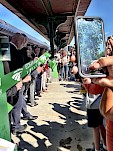
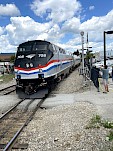

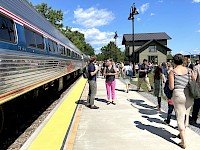
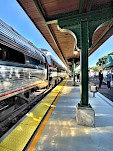
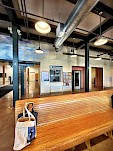
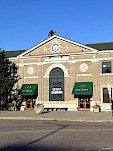

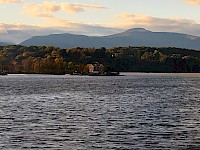
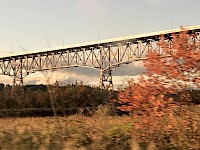
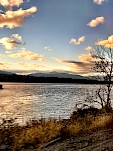
"The National Association of Railroad Passengers has done yeoman work over the years and in fact if it weren’t for NARP, I'd be surprised if Amtrak were still in possession of as a large a network as they have. So they've done good work, they're very good on the factual case."
Robert Gallamore, Director of Transportation Center at Northwestern University and former Federal Railroad Administration official, Director of Transportation Center at Northwestern University
November 17, 2005, on The Leonard Lopate Show (with guest host Chris Bannon), WNYC New York.
Comments